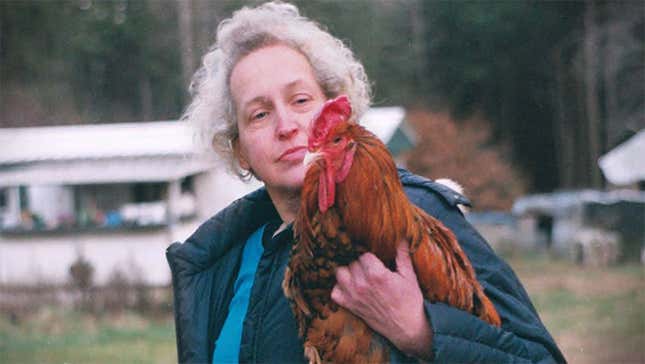
Image: Array
First-time feature director Richard Miron said he was on the edge of his seat for much of the time he spent filming For the Birds. When he set out to document the story of Kathy Murphy, whose nearly 200 birds became the cause of animal-rights activists and led to a courtroom showdown, Miron wasn’t quite sure what kind of movie he was making and where Murphy’s story would lead his camera. But he knew what kind of movie he didn’t want to make.
“I watched a couple of episodes of Animal Hoarders toward the beginning of making this film and I had to turn it off at a certain point,” Miron told Jezebel via phone last week. “It was really kind of making me sick how unethical it was. Those shows look at somebody as being a problem or an obstacle for the other people in their lives and the animals, and I think we really didn’t want Kathy to be portrayed as an obstacle to others. We wanted Kathy to be the protagonist who had obstacles in her way.”
Miron first met Murphy in winter of 2011, on a Woodstock Farm Sanctuary run to Murphy’s home in Wawarsing, New York. Miron had been volunteering at the sanctuary, which had been called in to attempt to help Murphy manage the flock of ducks, chickens, and turkeys she was keeping both inside her mobile home and in a pen out back. At Murphy’s home, the sanctuary workers found several sick animals and contended she didn’t have nearly enough space for so many birds (not to mention the lack of a pond for the ducks). Most anyone with an investment in hygiene could see that Murphy’s own living situation, with scattered feathers and feces inside her home, was substandard.
Though Miron entered the situation backing those ostensibly concerned with the animals’ welfare—who eventually took in and distributed to other sanctuaries several animals from Murphy’s home (almost all of the rest were eventually seized when the local SPCA stepped in)—the director soon realized Murphy’s story was no simple tale of good versus evil.“I think over time I realized that everything was more complicated than it seemed and people’s relationships to animals were always paradoxical in different ways—we’re all hypocritical in ways,” said the director, who is vegan and still considers himself an animal activist. “I was always interested in those gray areas and how we could explore that on screen and I wasn’t seeing animal rights movies that were doing that. That was kind of the genesis of me starting this project.”
He ended up with a rather complicated cast of characters. There was the Farm Sanctuary, which was attempting to provide a better life for the animals than what they perceived Murphy being capable of offering. There were the authorities acting in accordance with the law to stop the alleged “cruelty” to animals at hand. There was Kathy’s husband, Gary, who was fed up with having to share space with so many of his wife’s fowl friends. And then there was Kathy, who was attempting to do her best to provide animals (many of which she raised from hatchlings, some from fertilized eggs she purchased early on in her amateur husbandry) and displayed genuine emotional attachment to them. For the Birds is an extraordinary depiction of a situation in which everyone was convinced that they were doing the right thing. Its tension arises from the very definition of “the right thing” varying from person to person. Murphy’s situation spawned both the documentary at hand, and a 2012 viral video in which ducks rescued from Murphy are allowed in water for the first time and frolic accordingly. The glee vibrating throughout their bodies, making their little duck butts shake, is unmistakable. Both For the Birds and that YouTube video, uploaded by the Woodstock Farm Sanctuary, elicit empathy in their own distinct ways.
“There was something I read in a documentary book a long time ago about how right versus wrong is not interesting, but right versus right is interesting,” said Miron. “If you can show multiple truths existing at the same time and multiple moralities existing in the same place, that’s where [viewers] find the most interesting conflict. Every time I was with the sanctuary, I was seeing their perspective and trying to understand where they were coming from, and every time I was with Kathy, it was the same, and with Gary. Everybody was in conflict with each other and yet I had the space and time to understand their perspectives, or try to at least. I guess it’s kind of like an empathetic intention that I wanted the audience to feel vicariously through me.”Miron completed a short documentary on Murphy for his senior project (he graduated from Yale in 2012) but kept filming as Murphy’s story took its series of turns. In all, he shot her for about five years and then spent about two years editing.
-

-

-

-

-

-

-

-

-

-

-

-

-

-

-

-

-

-

-

-

-

-

-

-

-

-

-

-

-

-

-

-

-

-

-

-

-

-

-

-








































